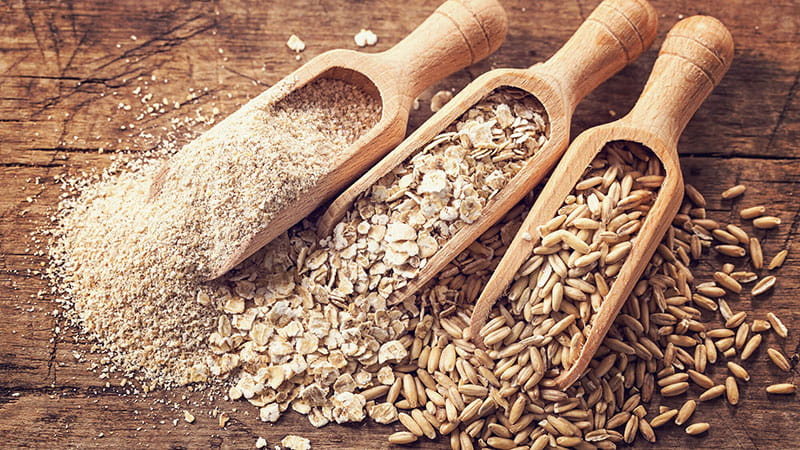7 Whole-Grain Foods You Should Try

Whole grains are important sources of fiber and nutrients. The American Heart Association recommends eating three or more servings of fiber-rich whole grains every day.
While you may be familiar with brown rice and 100% whole-wheat bread, there are many whole-grain options. And most are money savers, especially when you buy them in bulk. Here’s how to expand your whole-grain horizons:
Whole Grain: Barley
- Description: Barley is high in fiber. It has a chewy texture and nutty taste like brown rice. Barley is also found in packaged granolas, hot cereals and soup mixes. Hulled barley has the most fiber because its bran layer is not removed, and it takes the longest to cook.
- Common Sources: Hulled or hull-less barley or whole-grain barley
- Cooking Tips: Bring 3 cups of water to a boil. Add 1 cup of hulled barley. Reduce the heat to medium low. Cover and cook for 40 to 45 minutes. Cooked barley adds bulk and flavor to soups, casseroles, cooked vegetables. Almost any recipe that calls for rice can be replaced with barley. Toss cooked barley with your favorite cooked beans, chopped onions and fresh herbs for a twist on plain rice and beans.
Whole Grain: Bulgur
- Description: Bulgur is made from wheat kernels that have been dried and boiled. It’s usually sold as fine or coarse. Sometimes bulgur is confused with cracked wheat, which isn’t previously boiled so it needs to be cooked longer than bulgur.
- Common Sources: Bulgur wheat
- Cooking Tips: Soak 1 cup bulgur in 1½ cups very hot water, and it’s ready in 15 minutes! Bulgur can be added to soups, meatballs, meatloaf or substituted for rice in cold and hot dishes. To make tabbouleh, a popular Middle Eastern grain salad, mix cooked bulgur with chopped parsley, mint, tomatoes, lemon juice and a drizzle of olive oil.
Whole Grain: Corn
- Description: Corn is a whole grain that’s available in many forms and is inexpensive, too. When buying corn products (flour, meal, grits) other than kernels, look for the words “whole-grain corn” in the ingredient list.
- Common Sources: Whole kernels (fresh, frozen or canned), popcorn, whole cornmeal, whole grits, corn tortillas (made with whole-grain corn or whole cornmeal)
- Cooking Tips: To cook cornmeal (polenta), mix 1 cup whole cornmeal with 1 cup cool water. Bring 3 cups water to a boil. Slowly whisk in cornmeal mixture. Reduce the heat to medium. Cover and cook for 10 to 15 minutes, stirring often. Use whole cornmeal to make muffins, cornbread or pancakes. Add corn kernels to salads, soups and casseroles.
Whole Grain: Millet
- Description: When cooked, tiny yellow balls fluff up like rice. Millet has a delicious, nutty flavor.
- Common Sources: Hulled millet or whole millet
- Cooking Tips: Bring 2½ cups of water to a boil. Add 1 cup millet. Reduce the heat to medium. Cover and cook for 20 to 25 minutes. After cooking, whip millet like mashed potatoes. For extra flavor, toast millet in a pan for 10 minutes before cooking. Add ½ cup to batter for banana bread or corn muffins for an added crunch.
Whole Grain: Oats
- Description: Oats are one of the most popular whole grains in America. They are inexpensive and easy to make. Choose steel-cut or old-fashioned oats. The plain bulk versions have no sodium, no sugar and no preservatives. Skip the flavored oatmeal products.
- Common Sources: Steel-cut oats, old-fashioned/rolled oats, quick or instant oats, whole oat flour
- Cooking Tips: Bring 2 cups water and 1 cup old-fashioned oats to a boil. Reduce the heat to medium. Cook for 8 to 10 minutes, or until creamy, stirring frequently. Cook your oatmeal in fat-free or low-fat milk for a creamier taste and extra nutrients. Mix in unsweetened dried fruit and unsalted nuts for a filling breakfast.
Whole Grain: Quinoa
- Description: Quinoa has a slightly crunchy texture. It is a high-protein whole grain.
- Common Sources: Whole-grain quinoa, whole-quinoa flakes, whole-quinoa flour
- Cooking Tips: To prevent it from tasting bitter, rinse quinoa before cooking. Bring 2 cups of water to a boil. Add 1 cup quinoa. Reduce the heat to medium. Cover and cook for 20 minutes. Use in salads, casseroles, hot breakfast cereals and bean dishes for a boost of nutrition and a nutty crunch.
Whole Grain: Sorghum
- Description: Sorghum is a cereal grain that originated from Africa and is now a major staple in the United States. It’s gluten free, making it a great option for those with celiac disease or gluten intolerances.
- Common Sources: Breakfast cereals, gluten-free breads and pasta, granola, syrups
- Cooking Tips: Make sure to rinse and drain whole-grain sorghum before using. Bring 3 cups of water to boil. Add 1 cup of sorghum. Reduce the heat to low. Simmer for 40 to 55 minutes, or until tender. Drain well. Use as a side dish, in pastas or hot cereal; make into overnight oats; or add some crunch to salads. Pop it to make popcorn.








